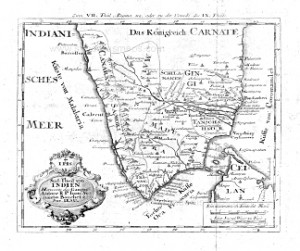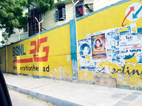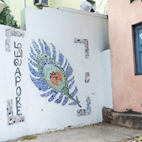Registered with the Registrar of Newspapers for India under R.N.I 53640/91
Vol. XXVI No. 13, October 16-31, 2016
Our Readers Write
Tannery effects
Prof. M.S. Swaminathan has stated (MM, October 1st) “The conflict between environment and development can be ended only if we can stop economic greed.”
In an Award passed by the Loss of Ecology (Prevention of pollution and Payments of Compensation) Authority constituted by the Central government on the orders of the Supreme Court in the Writ Petition filed by Vellore Citizens’ Welfare Forum, it was revealed that hundreds of dyeing units had polluted the Noyyal river, a tributary of the Cauvery, and had damaged 28,49,816 hectares of fertile farm lands in seven taluks of Coimbatore, Erode and Karur Districts. An Award was also passed by the Ecology Authority against 547 tannery owners for having damaged thousands of hectares of fertile lands which became unproductive, affecting the livelihood of 29,193 individual farmers.
The affected farmers and individuals were awarded compensation for the damage of their land, but it was very meagre when compared to the actual loss suffered by them.
I wrote to Prof. M.S. Swaminathan pointing out the heavy loss of crops due to the pollution caused by tannery effluents and in a letter dated 17-11-1989 he stated,
“My dear Subrahmanian, I thank you for your letter of November 14th. I am grateful to you for the papers you have sent. I agree with you that we must find methods of preventing damage to agricultural lands from tannery effluents. I shall do whatever I can in this matter.”
On 6-3-1992 the Tamil Nadu Agricultural University, Coimbatore, released a report stating 35,000 to 40,000 hectares of fertile farmland were destroyed by tannery effluents. Not much has changed.
P.S. Subrahmanian
“Ranga Villa”
No 8, Second Main Road
C.I.T. Colony
Chennai 600 004
Candidates needed
Even though the High Court has cancelled the civic polls, what MM said in its October 1st issue remains valied.
What do voters expect from candidates, be it from civic bodies, state legislatures or parliament?
A political party must ensure that its candidate has a passion to serve the public without expectations and a hidden agenda.
The candidate’s track record of public service must be closely examined before putting up the candidate for election.
If the candidate is seeking election for a second or more times, his or her performance in the previous periods must be closely audited
The candidate must be capable and reliable and understand his/her role and the importance of public service.
The candidate must have an adequate knowledge and feel for the voters’ problems and issues and attempt to solve them during the period of his/her tenure.
The candidate must never promise while campaigning what he/she cannot fulfill.
All the election promises of the candidates must be well documented/recorded and published and tested after their election/selection, periodically, and published for the benefit of the public/voter. Target vs actual performance must be visible in a transparent/quantifiable manner
The Marketing principle, “Never promise what you cannot deliver and always deliver more than what was promised and more than customer expectations”, must be adopted by the candidate.
The candidate’s capability/ability to serve voters must be quantified and be data-based, not opinion-based.
The candidate’s money power must be minimised and the hunger for popularity/power must be diminished.
The candidate must understand that voters keep watching his/her performances throughout.
There must be appropriate remedial course of action for defaulting councillors and this must be made known to the candidate when seeking election.
Candidates when elected must have adequate time and interest to meet and listen to voters’ problems and issues.
They must have time for voters and share their contact details with voters through newspapers and should visit voters once in a fortnight and inform them what good they have done thus far and what they would do before their next visit
The candidate must be free from vested interests and hunger for popularity and power
Dr. H.K. Lakshman Rao
33, Krishnapuri
Chennai 600 028
Jumble resolved
In the last issue of Madras Musings the Printer’s Devil had scrambled the first paragraph of Partab Ramchand’s ‘September memory’. This is how it should have read. We regret the error.
–The Editor
Thirty years ago, on September 22, 1986, at M.A. Chidambaram Stadium in Chepauk, Maninder Singh is given out lbw at 5.18 p.m. and the Test between India and Australia ends in a tie – only the second such result in 1052 matches.
The Jesuit seekers of knowledge
In my article published in Madras Musings on September 16th and October 1st, I have mentioned only some of the Jesuits who lived and worked in Madras and in Tamil Nadu. But then these individuals are not to be seen in isolation. They belong to a corporate body, The Society of Jesus. So, some general comments on their work in India are in order.
 Bouchet’s Map
Bouchet’s Map
Today the secular historians are highly critical about the missionaries in general and the Jesuits in particular. One historian calls them simply the “Jesuit travellers” and groups them as those who traveled in Asia for inspiring Asia and those who traveled in Asia for discovering Asia.
By ‘inspiring’ is meant to preach the Gospel values, studying local languages, making Christian literature available in these languages, while appreciating local cultures and religions. By ‘discovering’ is understood the traveling to the hitherto unexplored geographical regions of Asia, noting down the astronomical locations of various cities and towns, jotting down the happenings of their surroundings, contributing to the body of scientific knowledge of Asia.
This type of transference of knowledge and method of study was a part of the larger process of discovering and constructing India in a colonial setting, in which the role of the Jesuits was significant. But after the colonial experience of the subjugated nations, the term “discovery” becomes a loaded one. The so‑called ‘discovery’ led to a particular way of constructing the image of the ‘discovered’ people. Through their scholarly researches and ethnographic writings a new India emerged in the minds of the Europeans and also created a new self-understanding among the Indians themselves.
Though the categories of Jesuit ‘inspirers’ and ‘discoverers’ overlap in the case of many Jesuits, their contribution to literature and science has been substantial and significant. The substantial number of Jesuit literary contributors include Henry Henriques (1520-1600), Thomas Stephens (1549-1619), Roberto de Nobili (1577-1656), Joseph Beschi (1680-1747), Ernest Hanxleden (1689-1732), Heinrich Roth (1620-1668), Jean Francois Pons (1698-1752), Gaston Coeurdoux (1691-1779), Jean Calmette (1693-1739) and Joseph Tieffenthaler (1710-1785).
During the period between the 16th and 19th Centuries, priority was given to practical astronomy, due to the increasing navigational needs of those in search of new territories for commerce and colonisation. Navigation required accurate maps of harbours, coasts and islands, which in turn necessitated accurate observations of the position of certain stars and planets and the determination of longitudes and latitudes of locations. Many missionaries were cartographers and had the necessary equipment in their hands. There were over 25 Jesuits in expeditions to various parts of India, Nepal, Tibet, Bhutan and China during the 17th and 18th Centuries. Notable among them were Bento de Goes (1562-1607), Francis de Azevedo (1578-1660), Antonio de Andrada (1580-1634), Johann Grueber (1623-1680), Albert D’Orville (1621-1662) and Ippolito Desideri (1684-1733). They have left valuable sources for an ethnographical and geographical study of India.
Jean-Venant Bouchet (1655-1732) was responsible for the first dependable map of the interior of the southern peninsula. Bouchet, who arrived in India in February 1689, covered the Coromandel coast on foot, made astronomical observations at Pondicherry and prepared maps and sketches. His map of the southern peninsula was published in 1737 and was followed by his famous Carte de l’ Inde in 1752.
Bouchet, a French Jesuit, was known as Sanjvi Nathar in Tamil. Four of his works in Tamil are still available. Jnana Sanjivi was one of them.
In Madras and the Tamil regions, where they worked, the Jesuits played a great role at a particular time of history. They have left a large amount of writings in Tamil, which form part of the Tamil literary heritage, which is acknowledged by the scholars.
They may not remain in the “communicative memory” of the Tamil people which goes back perhaps to some 80 years or so at the most, but in the “cultural memory” which goes back to several centuries. They have found a place in Tamil tradition.
– Dr. Anand Amaladss
Dhyana Ashram
Making the ugly walls of Madras…
We are in the 21st Century. There are many gadgets, whatsapps and several other modes to communicate messages. Yet, painting on the walls by political parties and pasting of posters by politicians, film-makers and individuals continue as an eyesore in Chennai. These communicaters are yet to come out of these primitive ways of conveying messages. Why do the movie-makers indulge in pasting large posters on the walls, electricity junction boxes, telephone junction boxes and even road signboards, as if people go to films only after looking at these posters?
Magazines have now followed the trend. Instead of displaying their weekly or monthly magazine posters in the newsmarts, they blatantly paste them on the walls of houses of unknown people, making the walls ugly.
There are posters to announce the marriage or death of someone in some unknown colony. The huge pillars below the flyovers are also not left free. Posters of all political parties dominate them. At one of the flyovers, the beams bear the political leader’s name and face prominently and the local area leaders’ names are painted in colours that hit you in the face.
Do political parties think that the public is admiring this artwork, or the huge banners that block the pavements, while standing on the road?
One Traffic Ramasamy is not enough for Chennai to fight against this menace of targetting public walls, pillars and beams. Swachh Bharat also means clean walls and pillars.
We, the general public, do not know whether the Corporation has any control over this menace that makes the city look ugly. No other country, I believe, has allowed the use of walls of private individuals to such abuse.
If the throwing of household wastes in the corner of the street is one kind of attack on the cleanliness of the city, these posters and paintings are another kind of ‘acid attack’.
Another menace is fixing of ‘No Parking’ boards with the advertisers’ names on the gates of private apartments and buildings. There are a minimum five to six boards of various shapes and sizes hung on each gate. Other than advertising without permission the services or products, these boards serve no purpose. The irony is more vehicles are parked in front of the gates than before!
The Chennai Corporation authorities should do something to eliminate this ugly use of public spaces. A clean city is what local residents and visitors look for.
Some years ago, there was an ad by the Corporation of Madras, saying ‘Be Proud of Madras’. The editor of The Mail then wrote: ‘We are proud, in spite of the Corporation!’.
Charukesi
charukesiviswanathan@yahoo.co.in
… look better –with streetscape ideas
The grandly-planned streetscape for Luz church Road – wide pavements, central pavement median, displays of heritage spots of Luz and Mylapore, special lighting and street furniture – is now history.


The rear wall of the BSNL Mylapore telephone
exchange office (Left); a sample mural created on the wall
on Luz Church Road, opposite Nageswara Rao Park
(Right).
Some Mylaporeans challenged the idea, especially the central median plan and Chennai Corporation dropped the plan the next day, leaving no space for other people to debate the whole project.
Today, the wide pavements on either side of the road are being hijacked by hawkers. Some spots remain. And one such spot on the north pavement, opposite Amrutanjan and next to Nalli’s, is being designed. It will host a neighbourhood map and photos of local heritage and have street furniture. Work by contractors of the civic body has begun.
Architect Kavitha Selvaraj who designed the Luz Church Road re-design project hopes local residents can further enrich this spot. “People can line the wall with potted plants, for example,” she suggests.
As an extension of this streetscape spot on this road, Kavitha hopes to re-design the walls that wrap the local TANGEDCO and BSNL telephone exchange offices that flank Nageswara Rao Park and the street leading to Our Lady of Light Church, Luz.
Just now, one corner is a open urinal and some parts of the rear wall has BSNL’s promos painted on it.
“Can we use simple murals to showcase local heritage on these walls on both sides?” asks Kavitha.
As an experiment, her colleagues have designed a mayil (peacock) mural image on the wall on the edge of the BSNL office fronting the Park’s main gate.
“If we convince BSNL and others who use these walls and get Corporation to fund murals, we can change the streetscape here,” says Kavitha.
Mylapore Times reporter

